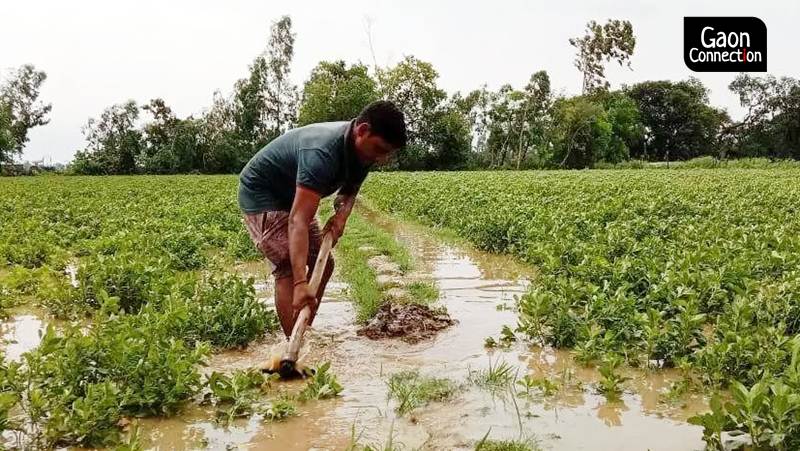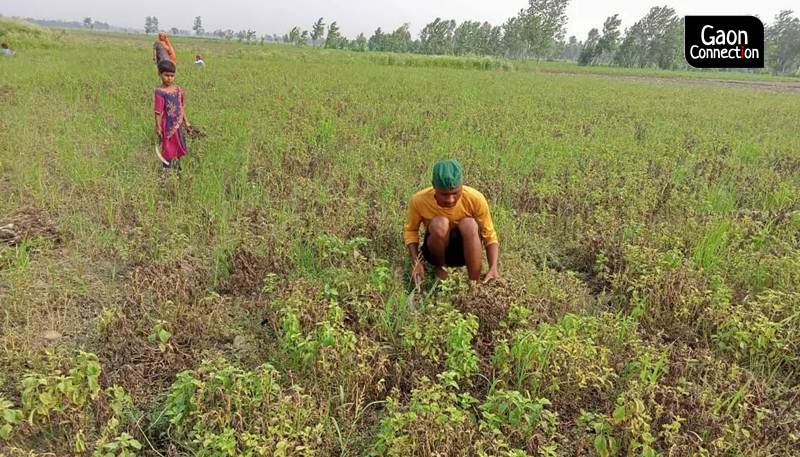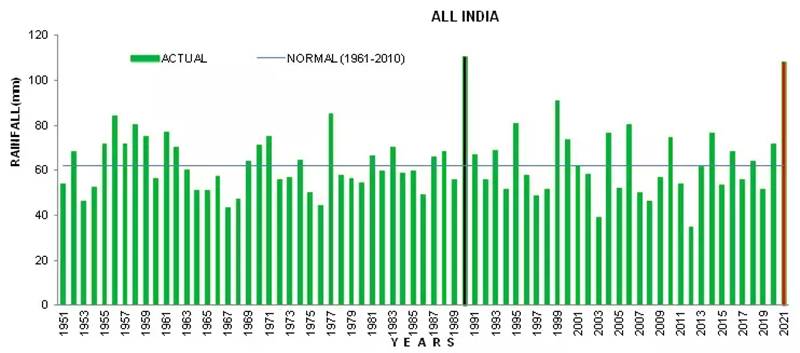No chill for peppermint farmers as rainfall damages crop in Uttar Pradesh
India is the world’s largest producer and exporter of peppermint, and close to 80% of the peppermint comes from Uttar Pradesh. But the recent heavy rainfall has washed away the harvest of farmers in the state. Can adopting the ‘Early Mint Technology’ help?

Barabanki, Uttar Pradesh
Prem Kumar, a peppermint cultivator, is disheartened to see his crop rotting in the field due to stagnant water. The past few weeks have been painful for him as heavy rains in the pre-monsoon season have damaged his peppermint crop which was ready to be harvested.
“Earlier it used to rain after June 1 but this year unseasonal heavy rainfall has troubled us like never before,” the 28-year-old farmer from Ghaghsi village in Barabanki, about 60 kilometers from the state capital Lucknow, told Gaon Connection.
His concern is lent credence by the rainfall data of the India Meteorological Department (IMD) which shows that May 2021 has been the second wettest May month in the past 121 years. And its impact is being felt by farmers like Prem Kumar whose crops have suffered heavy losses.
Also Read: As the Sarayu rises, hopes of sand farmers in Purvanchal drown

“The yield was really good this year. But the rains came like a disaster to us. Almost 70 per cent of my crop is ruined. Leave alone the profit, even the cost incurred in raising the crop will be hard to recover,” Kumar added.
Peppermint cultivation in India
Peppermint cultivation has been a ray of hope for the farmers who have been struggling to increase their incomes. The Indian government also motivates cuitivators to diversify their crops and include crops that sell at better prices. India is the world’ largest exporter of peppermint.
According to the National Horticulture Board, Uttar Pradesh contributes to almost 80 per cent of India’s total peppermint production. The cash crop is cultivated in districts like Barabanki, Chandauli, Sitapur, Varanasi, Moradabad, Badaun, Rampur, Lakhimpur Kheri, Bareilly, Shahjahanpur, Bahraich, Ambedkarnagar, Pilibhi and Raebareli. The crop is used to make peppermint oil, also known as mentha oil.
Also Read: Lease farmers harvest gloom on the fertile banks of the Sirsi river

According to the state’s Department of Horticulture and Food Processing, the cultivation is spread across 88,000 hectares of land and Barabanki alone contributes about 25 per cent to 33 per cent of the total peppermint oil production.
“India has attained position of primary and dominant source of mint oil and menthol in the world market, replacing China to a great extent due to (lower) price structure and comparable quality,” notes the department.
Peppermint farmers suffer huge losses
In Barabanki district’s Tandi village in Suratganj block, 35-year-old Anil Verma has lost his peppermint crop, too. “We had four acres [almost two hectares] of mentha (peppermint) fields. Three acres of my crop is spoiled, I am trying to get the water out from the field. Whatever crop has escaped the damage will hardly be enough for me to recover my costs,” he told Gaon Connection.
Talking about the economics of peppermint cultivation, Verma further informed that it takes 90-100 days for the peppermint crop to grow.
“An acre (half an hectare) of peppermint crop needs an input cost of around eighteen to twenty five thousand rupees. And crops in such acreage produce peppermint oil measuring 50 litres. But after rains spoiled the crops, the same acreage of crops is now giving out 10-15 litres of oil only,” lamented the farmer.
Production could be hit by 30 per cent
Sanjay Kumar, chief scientist at the Lucknow-based Central Institute of Medicinal and Aromatic Plants (CIMAP) told Gaon Connection that India is the largest exporter of peppermint oil in the world.
“Across the country, peppermint is cultivated over 300,000 hectares and the mint oil produced yearly is about 30,000 metric tonnes. Reasons arising out of weather affects the production. The rainfall that the state has witnessed in the last two weeks is expected to cut down the production by 30 per cent,” he said.
“In Barabanki, Gonda and Sitapur, it rained heavily on May 19 and May 20. After this almost daily rainfall was observed from June 1 which is continuing even now [June 14]. Most of the farmers harvest their crops between May 20 to June 25,” the scientist added.
He also informed that although the peppermint plant consumes more water than many other crops, it should be dry before extraction of oil.
May 2021 records second highest rainfall in 121 years: IMD
In its monthly report released on June 10, the India Meteorological Department has stated that the month of May, this year, has recorded the second highest rainfall in a period of 121 years.
IMD attributed this to two back-to-back cyclones (Yaas and Tauktae) and western disturbances for the record precipitation.
“Rainfall over India during the month of May was second highest since 1901. The highest rainfall occurred in the year 1990 (110.7mm),” the IMD said in its monthly report for May.

Early mint technique could solve farmers’ woes
Another scientist from CIMAP, Saudaan Singh told Gaon Connection that it has been observed that rainfall has been an issue for the farmers cultivating peppermint.
“Early Mint Technology which potentially reduces harvesting time by 20-30 days, increases the productivity of menthol mint by 15-20 per cent and minimizes expenditure on land, labour, water and fuel by about 20-25 per cent,” he told Gaon Connection.
Also Read: Now you can bite into crunchy apples from Mizoram and Manipur
“Also, the crop should be sown like potatoes are. By making drains in the field so that water comes out easily if it rains,” he added. Thus by employing this technique, the farmers can evade the pre-monsoon rainfall which often damages their crops.

